

CX220C Cx240C Tier 3 Service Repair Manual - DOWNLOAD



CX220C Cx240C Tier 3 Service Repair Manual - DOWNLOAD
Service Training Manual
Table of Contents
Section 1......General Introduction
Section 2......Component Locations - Hydraulics / Electrical
Section 3......Controller
Section 4......Electrical – “How it Works”
Section 5 ......Hydraulic – CX130/CX160 “How it Works”
Section 6 ......Hydraulic – CX210/CX240 “How it Works”
Section 7 ......Pressure Data
Section 8......Engine Electronic Fuel System
Section 9......Schematics



When programming the machines, the manufacture model number must be used. Detailed procedures are in section 7 of your service manual.
When programming the machines, the following codes will be used to change the language if necessary. Detailed procedures are in section 7 of your service manual.
The reservoir is pressurized on all models. The air charge is provided by thermal expansion and the differential area of the cylinders as they are stroked the first time. There is a breather/pressure regulator/fill cap installed in the top cover of the units. A rubber-covered button on top of the breather is provided to release the air pressure in the reservoir. A sight gauge mounted to the side of the reservoir indicates the oil level. There is a 150-mesh screen at the outlet of the reservoir to the hydraulic pump.
The oil returning from the main control valve flows through the oil cooler. There is a cooler bypass valve in the circuit to protect the system during cold start conditions. As the oil returns from the oil cooler, it passes through a full flow 10-micron filter. Some of the return oil is routed through a 1-micron ultra-fine filter. Drain oil from the pilot control circuits and the case drain oil from the swing and travel motors is returned through the main return filter.
A cartridge type filter is installed in the outlet of the pilot pump to protect all pilot valves from contamination. All of these filters have filter bypass valves for cold start up protection.
All of the CX Series Excavators use an open center hydraulic system, in that there is always an output flow from the hydraulic pump flowing through the system. The CX Series Excavators use a variable volume piston pump system to be able to fully use the engine horsepower available. As the system operating pressure increases, the flow gradually reduces, to maintain a constant horsepower load on the engine. The theory is that when very high pressures are required, speed isn't so important. The CX Series Excavators use a twosection variable displacement piston pump, to provide the flow required to operate the functions. Variable pumps are used to allow the delivery of a higher flow rate at lower working pressures, and then allow the pump to reduce flow at higher pressures to keep from stalling the engine. The increased flow at lower pressures makes the machine cycle faster, to increase the overall efficiency of the machine.
The engine horsepower required to drive a hydraulic pump depends on the flow delivered by the pump, as well as the pressure at which system is operating. There is a mathematical formula to calculate the pump drive horsepower, but a rule of thumb to visualize this, is that it requires approximately 1 engine horsepower to deliver 1 gallon per minute of oil at 1500 psi. Therefore, it would require 25 HP to deliver 25 GPM at 1500 psi. If the pressure increases to 3000 psi, the requirement would be 50 HP.
The CX Series Excavators have an automatic pump de-stroke feature that reduces pump flow to a minimum delivery when all control levers are in the neutral position. This is accomplished with a hydraulic pilot signal from the control valve. This system saves fuel and eliminates wasted engine and hydraulic power. The minimum flow delivery of the pumps increases with machine size and engine horsepower. Although the pump configuration and manufacturer varies, in principal, all of the pump control systems operate the same.
The attachment controls are pilot operated by hand actuated controllers on all models. The pilot hand controls are mounted to tilting armrests that can be positioned to provide for maximum operator comfort. The standard control pattern is the SAE pattern. The controls can be changed to other configurations by changing the pilot hose connections at the pilot manifold, located behind the cab (see Section 3 of this manual for instructions). There is a pattern change kit available as an option. This allows pattern changes without moving hoses.
When the left arm is tilted up or the gate is up, all pilot operated control functions are inactive.
On all models, the travel system is actuated by foot pedals that also have hand control levers attached. The travel controls are pilot pressure operated on all models. The CX240 has the single pedal feature, by actuating a single control pedal, both travel systems will travel at the same speed and direction. This feature gives the operator straight-line travel in either forward or reverse.
All models use a triple hydraulic pump assembly that is located on the same side of the unit as the reservoir. All of the units use two variable displacement piston pumps for the machine functions. A fixed displacement gear pump used to supply pilot control oil for the system. The CX130 and CX160 units use a tandem mounted pump supplied by Uchida. The CX210 and CX240 units use a tandem mounted pump supplied by Kawasaki. All of the pumps have a system to limit the horsepower load on the engine. This system allows the unit to fully utilize the power available without overloading the engine. The CX Series Excavators have an electrically controlled feature that allows the hydraulic system to operate at less than full load to increase fuel economy or fine touch controllability.
This feature allows for four digging modes:
“Auto” -Variable- 90-85% engine speed- 93-90% hydraulic pump torque
"H" -Heavy Duty - 100% of engine speed - 100% hydraulic pump torque
"S" -Standard Duty - 95% of engine speed - 90% hydraulic pump torque
"L" -Light - 85% of engine speed - 70% hydraulic pump torque
The machine will be in the ”Auto” mode each time it is started.
All models have Power Boost
CX130/CX160 machines have One-Touch Power Boost
CX210/CX240 machines have automatic Power Boost.
CX130/CX160/CX210/CX240
There is a single main relief with a second (power boost) setting. Boom and arm anti-drift valves are built into the main control valve. An auxiliary control valve is standard and a factory installed or field installed kit with plumbing to the end of the arm is available. Other features that are built into the main control valve are:
Dual flow boom up
Boom down regeneration
Boom down anti-drift
Dual flow arm
Arm in regeneration
Arm in anti-drift
Travel priority
Swing priority
Neutral pump de-stroke
Two electrical pressure switches are installed on the main control valve, and one in the swing pilot shuttle valve. These switches are used to tell the controller what hydraulic functions are being operated.
The CX Series units have an attachment control cushion system to allow the boom and arm cylinder control spools to gradually return to neutral, for shock-free operation. This feature allows a lesser skilled operator to work more smoothly. With the control cushion system active, the pilot oil from the hand control flows to the arm or boom control spool unrestricted. When the hand control is returned to neutral, the pilot oil is restricted as it leaves the control spool. This slow return of the spool accounts for the smooth operation. The system can be overridden with an electrical control switch on the monitor/switch panel.
The CX Series Excavators do not have a mechanical house lock. The house lock is accomplished with the swing brake. Swing lock or (100%) brake is applied when the switch on the left console is activated or the engine is shut off. The swing brake is applied 5 seconds after the control is returned to neutral.
The travel motors are located at the rear of each track assembly. The travel system is controlled by control spools in the main control valve located in the machine upper section. The travel drive system has independent, compact, axial piston, two speed hydraulic motors. Each track is independently driven by a sprocket driven by a planetary reduction unit. There is a spring applied hydraulically released disc brake built into each motor. The travel brake is released by the travel pressure applied to the motor. Each travel motor is equipped with a counterbalance valve and a dual stage relief valves for smooth starts and stops. The counterbalance valve prevents over speeding of the motor while driving down an incline. The shockless relief valve allows for additional cushioning in the circuit by allowing a slight transfer of oil between travel directions as the unit is started and stopped. The travel motors and reducers are mounted within the width of the side frame. Two-speed travel is controlled by the contr9oller, which controls a solenoid valve. The travel speed solenoid supplies pilot circuit pressure to actuate the two-speed spool in each drive motor. Travel drive pressure is then ported through the two-speed control spool to the motor swash plates. The machines are in “LOW SPEED” travel when the key is turned on. When the travel switch is depressed the machine will be in “HIGH SPEED” and if the drive load is to high the motor will automatically shift to “LOW SPEED” and back to “HIGH SPEED” when the load is reduced.
The travel systems have a travel priority function to insure straight travel capability if the swing function or any attachment function is activated, while traveling. When traveling without other functions activated, one pump supplies right travel with the other pump supplying left travel. When the travel priority spool shifts, because of multiple function application, one pump is used to supply both right and left travel while the other pump is used for the attachment functions. With one pump supplying, both travel functions, the travel speed will naturally be reduced significantly.
Cylinders
The attachment cylinders have a cushion feature to hydraulically reduce the speed of the cylinder rod at the extreme ends of travel to limit the shock on the machine. Bucket open and boom down cylinder positions do not have cushions.
All models have a 24-volt starting and charging system. The CX Series Excavators have two 12-volt batteries, wired in series to obtain the 24-volt capacity. These batteries are located in the compartment behind the cab.
There is a battery relay connected between the positive battery cable and the machine electrical system. The battery relay acts as the master disconnect for the system. The battery relay closes as the key switch is turned to the "on" position.
To improve starting at cold temperatures the CX130 and CX160 are equipped with an ether injection system as standard equipment. The ether injection system can only be activated when the key-switch is in the crank position. There is a rocker switch located in the left-hand control console for easy access to the operator. There is also a temperature switch located on the engine intake manifold to prevent engagement of the ether system when the engine is above approximately 40°F . On the CX210 and CX240, an intake manifold heater is used for cold starting assist.
The Alternator is rated at 24 volts. The electronic controller for the CX130/CX160 machine requires an engine speed signal from a magnetic sensor on the flywheel. This engine speed signal is extremely critical to machine functions. The CX210/CX240 machines have electronic control engines. The machine controller requires input from the engine controller.
The engine, the hydraulic, and the electrical systems are all monitored by a controller. The controller for the CX130/CX160 is different than for the CX210/CX240. The controller receives signals from sending units. Very simply, the controller takes the information that it has received, and then sends the required outputs to cause the machine to perform as selected. These outputs may be sent to the display panel to indicate a malfunction or to give a visual display of which performance features have been selected. The outputs may also be sent to the solenoid valves, which control the machine functions. The controller has an automatic “limp home” feature to allow the machine to be operated to complete the job in case of controller failure.



CX130/CX160
The CX130/CX160 could be considered sister machines because they are so similar. Electrically they are identical. Hydraulically the components are the same except for greater flow rates required by larger machines.

The CX210 / CX240 could be considered sister machines because they are so similar. Electrically they are identical. Hydraulically the components are the same except for greater flow rates required by larger machines.
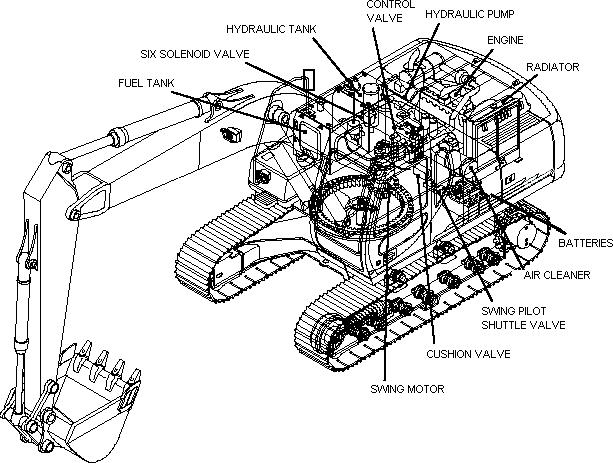
CX130
Because of the similarity, the component locations are the same between CX130/CX160 .
1. Free swing solenoid valve
2. Travel alarm
3. Boom light
4. Swing pilot pressure switch
5. Horn (low note)
6. Horn (high note)
7. Upper pressure switch
8. Work light (upper-structure)
9. Windshield washer motor
10.Not available on north american models
11.Fuel level sender
12.Travel pressure switch
13.Pump proportional solenoid valve
1. Horn switch
2. Gate lever
3. Auxiliary hydraulic select switch
4. Door limit switch (A/C)
5. Air conditioner
6. Fuse box
7. Machine electronic controller
8. Throttle motor driver
9. Engine emergency stop relay
10.Work lights relay
11.Horn relay
12.Ether start relay
13.DC-DC converter (24v-12v)
14.Solar radiation detector
14.Six solenoid valve bank
15.Negative (de-stroke)pressure transducer (pump2)
16.Pump2 pressure transducer
17.Pump1 pressure transducer
18.Hydraulic oil temperature sender
19.Battery disconnect relay
20.20 amp fuse
21.20 amp fuse
22.65 amp fuse
23.Batteries
24.Coolant level sender
25.A/C compressor clutch switch
15.Radio
16.Cigarette lighter
17.Air condition control
18.Key switch
19.Throttle control
20.Instrument/switch panel
21.One touch/auto idle control
22.Windshield limit switch (A/C)
23.Windshield wiper motor control box
24.Windshield wiper motor
25.Cab interior light
26.Option switch
27.Power boost switch
28.Option relay

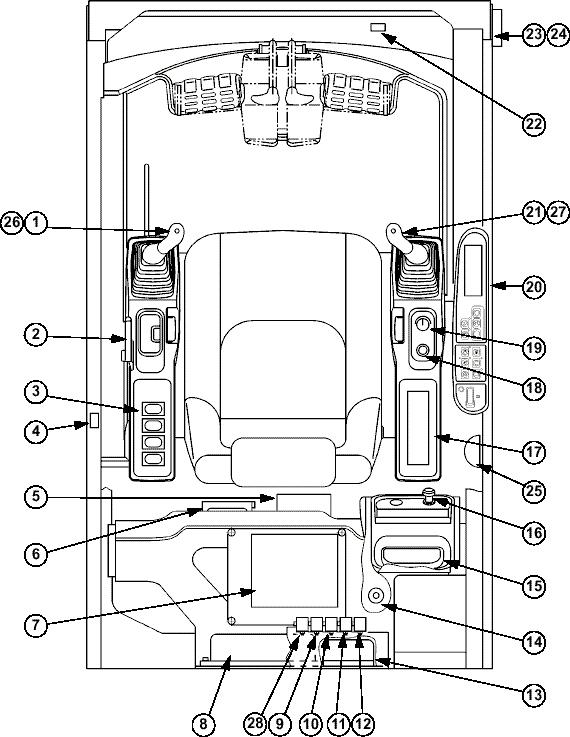
Because of the similarity, the component locations are the same between CX210 / CX240.
1. Free swing solenoid valve
2. Travel alarm
3. Boom work light
4. Swing pilot pressure switch
5. Horn (low note)
6. Horn (high note)
7. Upper pilot pressure switch
8. Work light
9. Windshield washer motor
10.Not available on North American models
11.Fuel level sender
12.Travel pilot pressure switch
1. Horn switch
2. Gate lock lever
3. Auxiliary select switch
4. Door limit switch (A/C)
5. Air conditioner
6. Fuse box
7. Machine controller
8. Option switch (left)
9. Engine emergency stop relay
10.Work lights relay
11.Horn relay
12.Option switch (right)
13.DC-DC converter (24v-12v)
13.Pump proportional solenoid
14.Six solenoid valve
15.Negative (de-stroke)pressure transducer
16.Pump2 pressure transducer
17.Pump1 pressure transducer
18.Hydraulic temperature sender
19.Battery disconnect relay
20.20 amp fuse
21.20 amp fuse
22.65 amp fuse
23.Batteries
24.A/C compressor clutch switch
14.Solar radiation sensor
15.Radio
16.Cigarette lighter
17.Air condition control
18.Key switch
19.Throttle control
20.Instrument/switch panel
21.Engine control
22.Windshield limit switch (A/C)
23.Windshield wiper motor controller
24.Windshield wiper motor
25.Cab interior light
Outside the Cab
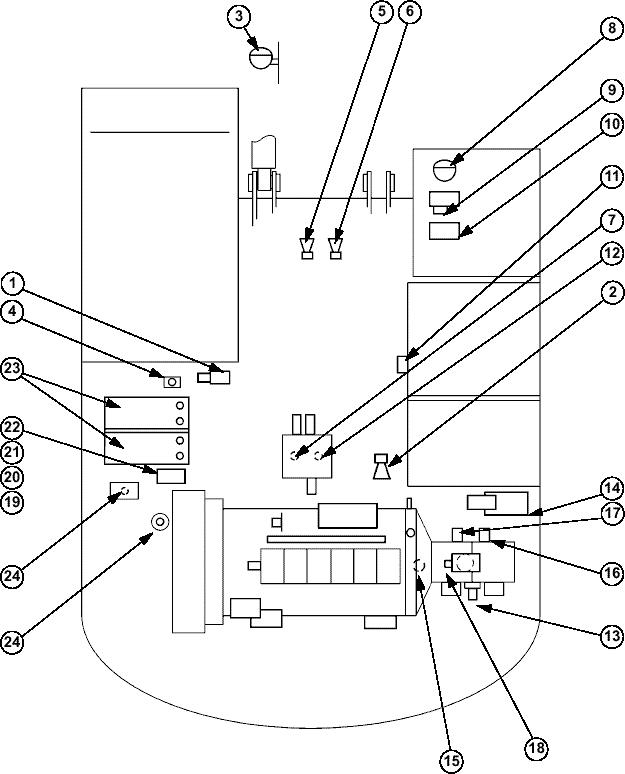
the Cab
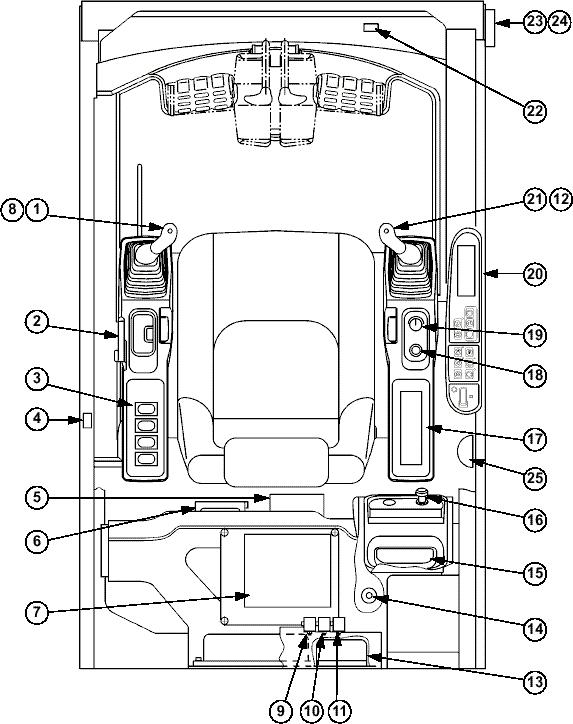

F1 10A: Data test link
F2 20A: Controller/Instrument/Switch Panel
F3 20A: Controller power
F4 10A: Pilot solenoid (gate lever)
F5 15A: Option
F6 20A: Option
F7 20A: Fuel feed pump
F8 10A: Air suspension seat
F9 10A: Condenser fan
F10 10A: Auxiliary hydraulic solenoid valve
F11 10A: Instrument panel/Radio/DC-DC converter
F12 10A: Key switch
F13 20A: Air conditioner/heater
F14 5A: Air conditioner compressor
F15 15A: Work light
F16 15A: Option
F17 10A: DC-DC converter
F18 15A: Wiper and washer
F19 10A: Horn
F20 10A: Cigarette lighter
Main Fuses and Battery Relay All Models (battery compartment)
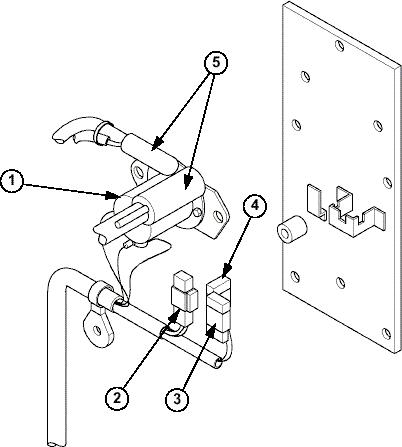
1. Battery disconnect relay
2. Fuse 65A: fuse circuits F3 to F10 and F13 to F20
3. Fuse 20A: fuse circuits F1, F11 and F12
4. Fuse 20A: fuse circuits F2
5. Battery cables
Instrument Panel All models

1. Travel mode switch
2. Work mode switch
3. Auto work mode switch
4. Buzzer stop switch
5. Swing lock switch
6. Engine emergency stop switch
7. Hourmeter
8. Cushion switch (off)
9. Free swing switch
10. Work light switch
11. Windshield wiper switch
12. Windshield washer switch
13. Display screen
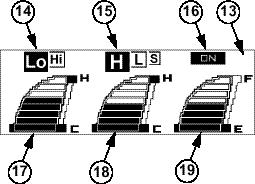
14. Travel speed indicator
15. Work mode indicator
16. Idle mode indicator
17. Coolant temperature
18. Hydraulic oil temperature
19. Fuel level
CX130 / CX160
Port
4A3 Bucket close
4B3 Bucket open
4A2 Boom lower
4B2 Boom raise
4A1 LH forward travel
4B1 LH reverse travel
Description
5A5 Arm (dipper) retract (close)
5B5 Arm (dipper) extend (open)
5B2 RH swing
5A2 LH swing
5A4 Option circuit
5B4 Option circuit
5A1 RH forward travel
5B1 RH reverse travel
PR – PL Pump inlet, P1-P2
P0 – OPT Supply to option spool
R1 – R3 Plugged
R2
FL – FR Neutral de-stroke signal
PX1 Upper pressure switch
PX2 Travel pressure switch
PS1
DR1 – DR2 Leak-off return
PS2 Boom/Arm (dipper) anti-drift pilot pressure
R5 By-pass return
R4 To cushion valve heat circuit
Pi1 Swing priority
Pi2 Cut valve
Pi3 Arm (dipper) parallel circuit